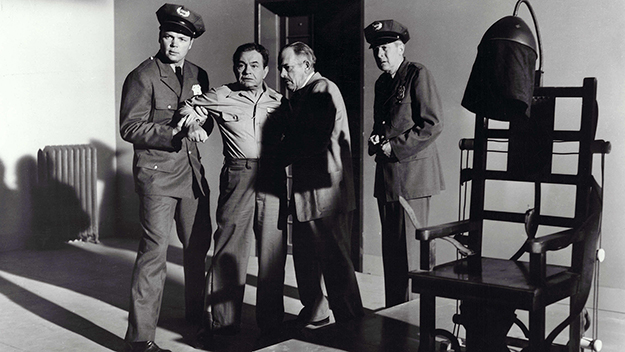The Stuff of History: Il Cinema Ritrovato 2022
This article appeared in the July 26, 2022 edition of The Film Comment Letter, our free weekly newsletter featuring original film criticism and writing. Sign up for the Letter here.

Black Tuesday (Hugo Fregonese, 1954)
Every year, the Il Cinema Ritrovato festival in Bologna, Italy reveals and rediscovers the vitality of older films in critical relation to the present. In its 36th edition, the 2022 crop featured among its diverse offerings a program dedicated to the actor Peter Lorre—including highlights The Face Behind the Mask (1941) and The Beast with Five Fingers (1946), both directed by Robert Florey—as well as an overview of Yugoslav cinema, pre-Nazi German musical comedies, and a retrospective of Japanese genre auteur Kenji Misumi. At this year’s opening ceremony, the festival directors—Cecilia Cenciarelli, Gian Luca Farinelli, Ehsan Khoshbakht, and Mariann Lewinsky—observed matter-of-factly that many of the films featured in the festival “could not be made today.” For Il Cinema Ritrovato, restoration has never been simply an act of conservation; it’s also a mode of reactivation, a way to think through the contemporary state of cinema by simultaneously feeding and challenging its historical consciousness.
One of this year’s outstanding retrospectives was dedicated to Hugo Fregonese, an Argentine director of Italian origins whose movies expose the inherent violence of borders. Over the course of a career that spanned three decades, from the mid-’40s to the mid-’70s, Fregonese made films in six different countries. The director’s Hollywood phase, which constituted the bulk of the retrospective, lasted five years and spanned 10 films.
Fregonese’s Hollywood films train his unsentimental, cynical eye on the lives of vagrants and fugitives, people with nothing left to lose. In 1954’s Black Tuesday, a group of death-row inmates, led by the vicious Vincent Canelli (Edward G. Robinson), pulls off a spectacular prison break, only to end up trapped in a warehouse, waiting on a doomed standoff with the law. The state’s cruelty can hardly be distinguished from that of the hardened criminals, except that it operates under the sanctimonious cover of justice. Devoid of any edifying messages, Fregonese’s final Hollywood film frames mutual violence as the ultimate social currency—a matter not of individual choice but of structural determination.
The director’s materialist view of history is on even sharper display in The Raid (1954), a proto-Peckinpah western in which renegade Confederate soldiers plan to rob a local bank in a guerrilla-style attack, complete with Molotov cocktails. Set in Vermont, near the Canadian border, the film eschews outright judgment of the Confederate bandits’ actions and grants them a successful final escape. Fregonese does not condone the crimes of the men but shows how the average man is, for better or worse, driven by contingency rather than ideals.
The subject of a small tribute at the 2015 edition, Albert Samama Chikli, an Arab-Jewish pioneer of Tunisian cinema, returned to this year’s festival as part of One Hundred Years Ago, an annual section featuring films from 100 years prior. A selection of homemade films and newsreels Chikli shot in 1922 were shown during a presentation of his personal archives, which have been acquired and digitized by the Cineteca di Bologna. The program’s highlight was a 35mm fragment of Chikli’s only extant fiction film, Zohra, written by and starring his daughter Haydée (then only 16 years old), about a young girl adopted by nomads. Also of interest was the short Les écoles de l’Alliance Israélite Universelle en Tunisie, a seven-minute newsreel documenting the daily activities of the local Jewish schools in Tunisia. Though not above your average newsreel in stylistic terms, this short is of great historical importance, as it might well be the only audiovisual artifact documenting the existence and activities of the Alliance Israélite Universelle—a French Jewish political organization founded in 1860—in Tunisia.
Having virtually disappeared after opening the Venice Film Festival in 1962, Franco Rossi’s Smog was exhumed from oblivion and presented in a vintage print. Rossi was a minor figure in the history of Italian cinema whose biggest claim to fame was a 1968 sword-and-sandals adaptation of The Odyssey for TV. Smog, however, provides evidence of unfulfilled promise. The first Italian film to be entirely shot in the U.S., it chronicles 48 hours in the life of a lawyer from Rome who is trapped in Los Angeles due to a delayed flight. The protagonist is dragged through the lives of a group of Italian immigrants by a questionable compatriot, met randomly at the airport, whose shady deals are the film’s narrative engine, taking us from one vignette to the next. Shot by Ted McCord, the cinematographer of The Sound of Music, the film is a lateral view of Los Angeles as lived and deciphered by these expatriates chasing the chimeras of the American dream. Devoid of any social texture and narrative, the city and the film are held together by the schemes that each character pursues, oblivious of the consequences for those around them. This unconventional film, a sui generis gem that has not heretofore received its due, exemplifies the unsettling potential of Il Cinema Ritrovato, a festival that does not merely celebrate the cinema of the past but questions it in order to reconfigure our present.
Giovanni Vimercati is a film scholar and critic whose work has appeared in Cinema Scope, the Los Angeles Review of Books, MUBI Notebook, Film Quarterly, Filmmaker Magazine, Sight & Sound, and other publications.







